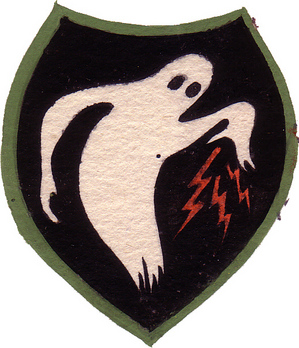Ghost Army exhibit and film shed light on WWII’s elusive phantoms
Chances are that you have never heard of the U.S. Army’s World War II unit the 23rd Headquarters Special Troops. This formerly top-secret group, which was appropriately nicknamed the Ghost Army, made it their business to remain phantoms in the shadows.

By creating elaborate illusions, or “shows,” the Ghost Army successfully convinced the enemy of complex deceptions in order to influence their tactics and protect American soldiers. Members of the unit adhered to a code of silence, much of the information was classified for decades, and even many Ghost Army family members had no idea of their activities during the war.
The University of Michigan's Hatcher Graduate Library is currently displaying photographs, artworks and other materials created by Ghost Army soldiers, as well as quotes from soldiers and a comprehensive narrative text that Exhibits and Outreach Librarian Karen Jordan based on research conducted by U-M history Ph.D. student Diana Mankowski.
The materials and text chronicling this almost unbelievable story will be on display in the Hatcher Library’s Room 100 Gallery through April 30. In addition, nationally known documentarian, author and journalist Rick Beyer will screen a rough cut of his upcoming documentary film “The Ghost Army,” in the Room 100 Gallery on Wednesday, March 17, beginning at 7 p.m.
Beyer — whose works have appeared on the History Channel, at the Smithsonian Museum of American History and at Mount Vernon — contributed most of the materials featured in the Ghost Army exhibition. Materials include paintings, drawings, photographs and 1 diary entry written under-the-table. He is looking forward to sharing the Ghost Army’s story through a multitude of media, which he collected during his research for the film.
After getting a lead from a friend to speak with Ghost Army veteran John Jarvie’s niece, Beyer was inspired to make this into his first independent documentary film. He reports that he set out right away to interview living Ghost Army vets from as many as possible of the different divisions, or arms, that made up the 23rd Headquarters. The filmmaker is including video taken from 20 interviews that he had with Ghost Army members in the film, as well as images and archival materials he collected from the soldiers, their families and research in the National Archives.
Different arms of the Ghost Army specialized in 4 main types of deception in order to orchestrate “scenarios” that were “illusions that somebody else would believe, and that would add up in their heads,” Beyer explains. A “sonic deception” arm broadcast layer upon layer of pre-recorded sounds that mimicked troop activities, such as the sounds of tanks and trucks, people building bridges and anything else that would normally happen in a given scenario.
The “visual deception” soldiers would dupe the enemy with elaborate stagings, which included inflatable rubber tanks, airplanes and other vehicles. The Ghost Army also had a “radio deception” division that contributed fake transmissions to the con. Another kind of deception involved “special effects,” which might make it seem like an American General is at camp — suggesting to the enemy that there were more troops present than there actually were, for example.
Beyer compares the Ghost Army’s “traveling show” to creative pursuits like “playacting,” “soundscapes” and “set-dressing,” and he concludes that “it’s ultimately a story about imagination.” According to the filmmaker, “the forms of deception they used were creative,” because “it is an act of imagination to get your message into the brains of people on the other side of the front line,” he says.
Jordan reports that “there were a lot of artists in the Ghost Army. Many of them went on to pursue art careers. The quality of the artwork (in the exhibition) is amazing.” In fact, the army purposefully recruited artists for its “visual deception” unit, including men who went on to become famous, like fashion designer Bill Blass, who spent his free time documenting European women’s fashion.

Image courtesy the University of Michigan Hatcher Graduate Library
Most of the artworks and photographs on display in the Ghost Army exhibition do not depict their acts of deception. The men spent their time capturing glimpses of locations and people all over Europe, portraits of each other, and quite a few images inspired by their visits to brothels. However, the exhibition also showcases a number of images and 1 journal entry written by visual deceiver Bob Tompkins, which actually document their deceptions.
For example, 1 of the photographs on display shows Ghost Army soldiers lifting up a rubber tank. A similar painting documents an encounter with 2 French bicyclists who stumbled upon them doing this. Jordan thinks that this particular image reveals “how easily it could all turn badly. It definitely says a lot about how important secrecy was,” she says.
When Beyer learned of the Ghost Army, he thought “it was too good of a story to let go,” he says. A few books have been written about the group; however, “it’s kind of a lost story. World War II history written before this wasn’t a secret any more. It didn’t get into the books and movies about the war,” he explains. By telling their story on film, sharing his research materials in the exhibition and growing the film’s web site into an digital archive and communication tool, Beyer hopes to introduce the Ghost Army’s story to a wider audience.
Jordan agrees with Beyer that “this is a story that is rarely known. Rick is committed to getting the story out and I know that the children of Ghost Army veterans want to get it out. I also think we at the library know that this is an important story to tell. We have books about it in our stacks, but people don't really know about it,” she says.
Beyer hopes that PBS or another network will pick up the documentary. He may also consider submitting it to film festivals. The library’s screening of the film will be a unique opportunity to give him your honest feedback, and he plans to stay and answer questions “until the cows come home.” “For people who are interested in coming, on one hand you’re not going to get to see a finished project, but on the other hand your getting a chance to maybe influence how the film ends up being created and contributing ideas to it,” Beyer explains.
The Hatcher Graduate Library is located on the University of Michigan Diag, at 913 South University Avenue, in Ann Arbor. The library's Room 100 Gallery is located toward the back of the main lobby, on your left hand side as you enter the building.
Watch a trailer for the "Ghost Army" movie:
Jennifer Eberbach is a free-lance writer who covers art for AnnArbor.com.


Comments
Darell English
Tue, Mar 9, 2010 : 10:12 a.m.
One more for the Histoy Books